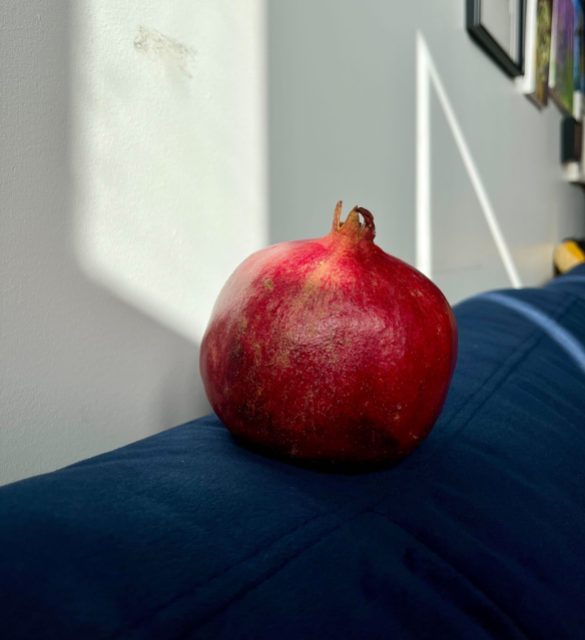
So you bought a pomegranate. Maybe it caught your eye when you were aimlessly wandering the grocery store produce section, waiting for your partner to come back with the cart. Maybe you already know that you love pomegranates but don’t want to pay an exorbitant price for pomegranate seeds. Or maybe you’re trying to incorporate some Hades-Persephone role play into the bedroom. Whatever your reason, congratulations — you have the best (and prettiest) winter fruit. And good timing on your part, too! Technically, the growing season for pomegranate is over, but they store so well that you can usually get them (in the US) through the end of January.
For millennia, pomegranates have symbolized fertility and abundance. Their symbolic use cuts across cultures and religions, and they’ve even had a lasting impact on the English language: both “grenade” and “garnet” come from the word “pomegranate”. I love a pomegranate, but between getting the seeds out without making a mess, and then figuring out what to do with the abundance of seeds, they require a fair bit of work. But I promise it’s worth it! Here are some key pomegranate tips.
Extracting Pomegranate Seeds
Hidden beneath the tough exterior of a pomegranate’s flesh are the arils, the gorgeous little jewels that are the real reason we buy pomegranates. Getting to the seeds can be tricky (especially if you’re trying to not make a mess) but there’s a way to make it easier. Slice the crown off, then score the pomegranate along the now-visible membranes. Then, slowly open the pomegranate along the scored sections to extract the seeds. If you do it over a bowl of water, the juice won’t stain your counter!
If you really don’t want to get your fingers in there, you can also whack the pomegranate with a spoon (once it’s cut and scored) to get some of the seeds out. But sometimes, this means that one ill-placed whack will result in pomegranate seeds flying everywhere, so be warned.
What To Do With Pomegranate Seeds
You could absolutely eat pomegranate seeds just as they are, but sometimes, a single pomegranate will yield more seeds than you need. If you have a bounty of seeds, consider making at least some of them into something else!
Make Pomegranate Juice, Then Grenadine
Grenadine is the key ingredient in a Shirley Temple and is traditionally made from pomegranate juice. Unfortunately, the ubiquitous bottled varieties rarely contain pomegranate (Rose’s, for example, doesn’t have any pomegranate in it). If you’re in the mood for a Shirley (or a Dirty Shirley) but would rather make the grenadine yourself, it’s quite easy — just time-intensive!

Take your pomegranate seeds (ideally ones on their last legs that you have no plans to eat otherwise) and blend them. Strain your blended concoction twice, and you’ll be left with pomegranate juice. You could absolutely stop here; fresh pomegranate juice is delicious on its own. But when combined with sugar and citrus peels (or, if you have it, a few dashes of orange flower water), and reduced on the stovetop to a more syrupy consistency, you get homemade grenadine. Mix it with some soda (or bubble water, if you’d rather have a drier drink!), and you’ve got yourself a mocktail.
Stew Some Meat
If you’re in a dinner rut, use your homemade pomegranate juice the next time you make a stew. The pomegranate’s sweetness and natural acidity pair well with red meat IMO! Honestly, I think you could use pomegranate juice anywhere you’d use red wine. If you’re a recipe person, consider Samin Nosrat’s Fesenjoon!
Assemble a Salad
I love using pomegranate seeds in salad, especially when they’re paired with a salty cheese. I love the sweet-salty-sour combination! Technically, this Ottolenghi recipe is more of a summer salad (lots of tomato action) but who’s to say you can’t have it year round? For something more wintry, maybe this roasted carrot salad.
Garnish Things
When in doubt, add a sprinkle of pomegranate seeds. They’re tiny little jewels of flavor! I’ve had guacamole studded with pomegranate seeds (delicious), rice pilaf with surprise bites of pomegranate, and cocktails with pomegranate seeds in them (though to be fair, I think the seeds served more of a decorative purpose in the cocktail). You could eat them with yogurt and granola, or make a tabbouleh and add them!








Comments
Thanks for share greet info.
Thanks again